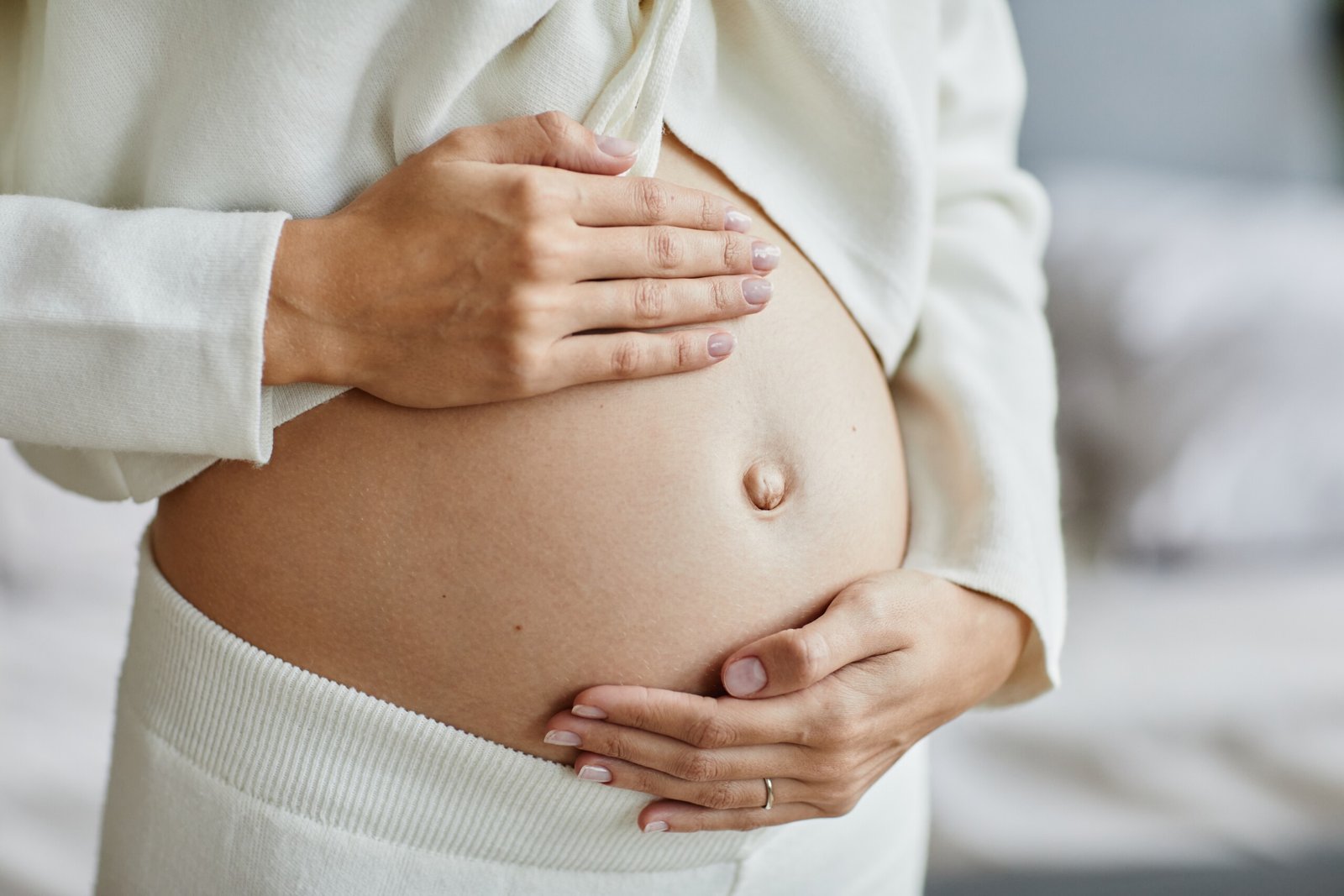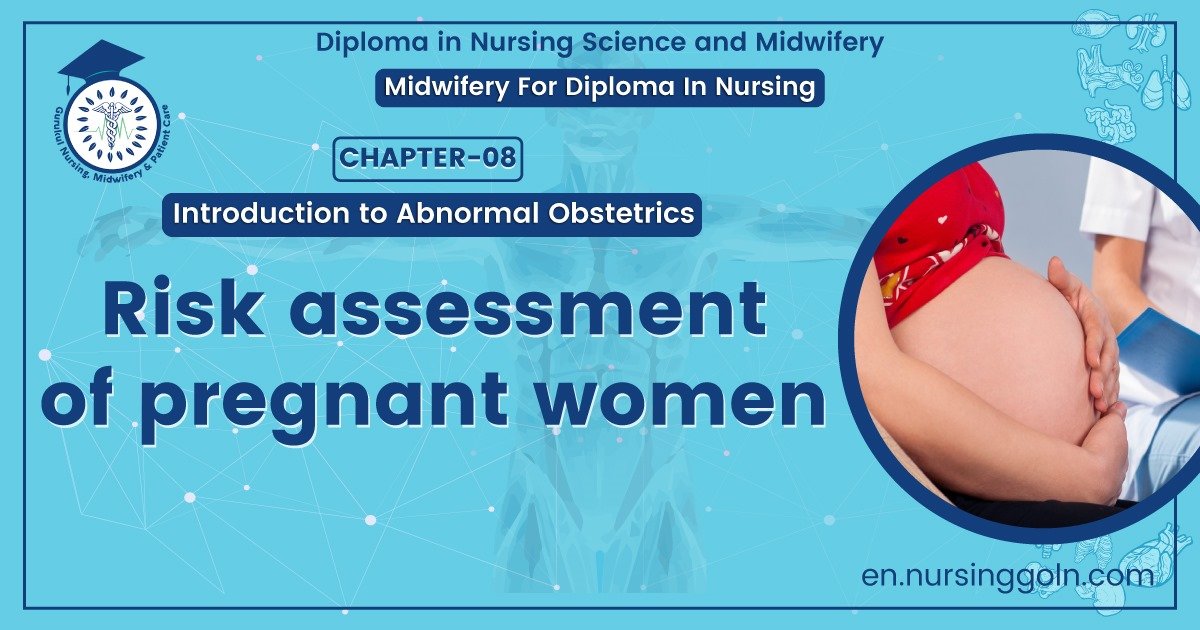Risk assessment of pregnant women – This course is designed to understand the care of pregnant women and newborn: antenatal, intra-natal and postnatal; breast feeding, family planning, newborn care and ethical issues, The aim of the course is to acquire knowledge and develop competencies regarding midwifery, complicated labour and newborn care including family planning.

Risk assessment of pregnant women
Definition of High Risk Pregnancy/Mother:
High risk pregnancy is defined as one which is complicated by factor or factors that adversely affects the pregnancy outcome – maternal or prenatal or both.
Danger Signs of Pregnancy
1. Swelling of the feet.
2. Convulsion.
3. Blurring of vision.
4. Convulsion.
5. Per-vaginal bleeding (even in small amount).
6. Per-vaginal discharge,
High Risk Pregnancies / WHO (1978) Criteria of High Risk Cases
A. During pregnancy:
➤ Elderly primi (> 30 years of age).
➤ Short stature primi (< 140 cm)..
➤ Threatened abortion & antepartum haemorrhage (APH).
➤ Malpresentation.
➤ Pre-eclampsia & eclampsia.
➤ Anaemia.
➤ Elderly grand multiparas
➤ Twins & polyhydramnios.
➤ Previous history of still birth, IUD, IUGR, manual removal of placenta.A
➤ Prolong pregnancy.
➤ History of previous caesarean section & instrumental delivery.
➤ Pregnancy associated with medical disease.
B. During labour:
➤ Pre-mature rupture of membranes (PROM).
➤ Prolong labour.
➤ Hand, feet or cord prolapse.
➤ Placenta retained more than half an hour.
➤ Post-partum haemorrhage.
➤ Puerperal fever & sepsis.
Diagnosis or Screening of High Risk Cases:
The cases are assessed at the initial antenatal examination, preferably in the 1st trimester of
pregnancy.
A. History taking:
Maternal age: Pregnancy 17 years years 35 years.
Family history
- socio-economic condition: poor socio-economic status a high incidence of anaemia
- IUG& preterm labour etc.
- Women who undertake long road journeys have a higher incidence of recurrent
abortion or preterm labour. - Family history of diabetes mellitus, hypertension, multiple pregnancy (maternal side), congenital anomalies.
Obstetric history:
- Two or more previous spontaneous / induced abortion.
- Previous still birth, neonatal death or
- birth of babies with congenital anomaly.
- Previous preterm or small for date or big baby (> 3kg) delivery.
- Grand multiparity.
- Previous caesarean section or hysteratotomy. Pre-eclampsia or eclampsia.
- Third stage abnormalities: This has a particular tendency to recur.
- Previous infant with Rh-isoimmunisation or ABO incompatibility
History of medical diseases:
- Pulmonary disease (e.g. TB)
- Viral hepatitis.
- Cardiac disease.
- Renal disease.
- Thyroid disease.
- Psychiatric diseases.
- Epilepsy
Past surgical history:
- Myomectomy.
- Repair of vesico-vaginal fistula (VVF).
- Repair of complete perineal tear
- Repair of stress incontinence.
B. Clinical examination:
General examination:
- Height: < 150cm.
- Weight: Overweight or underweight both are risk factor.
- High blood pressure.
- Anaemia.
- Cardiac or pulmonary diseases.

Per-abdominal examination:
- Genital prolapse
- Laceration or dilataion of the cervix.
- Associated tumor.
Follow up:
After initial visit, the high risk cases should be reassessed at each antenatal visit to detect, abnormality that might have arisen later; such as –
- Pre-eclampsia.
- Anaemia.
- Rh-isoimmunisation.
- High fever.
- Pyelonephritis.
- Haemorrhage or P/V bleeding.
- Diabetes mellitus.
- Large uterus.
- Lack of uterine growth.
- Post-maturity.
- Abnormal presentation.
- Twin pregnancy.
- History of teratogenic drug intake

Risk factors that affecting pregnancy:
- Biophysical factors
✓ Genetic considerations.
✓ Nutritional status.
✓Medical and obstetric disorders.
- Psychosocial factors
✓ Smoking
✓ Caffeine
✓ Alcohol
✓ Drugs
✓ Psychological status
- Sociodemographic factors
✓ Low income
✓ Lack of prenatal care
✓ Age
✓ Parity
✓Marital status
✓ Residency
✓ Ethnicity
- Environment factors
✓ Infections
✓ Radiation
✓ Chemical such as pesticides.
✓ Therapeutic drug etc.
✓Workplace.
Risk factors for obstructed labor:
Taking a proper obstetric history on every woman during prenatal care can identify important risk factors for obstructed labor. The following risk factors can be identified during history
taking:
- Young age of woman (under 17).
- Previous caesarean section or still birth.
- Previous prolonged labor.
Other risk factors are identified by physical examination:
- Noting stature, gait, evidence of pelvis affected by disease or injury (including poliomyelitis. Tuberculosis. Osteomalacia. Rickets).
- Measuring the women’s height (height< 150 cm usually indicates a small pelvis).
- Pelvic capacity assessment.
- Diagnosis the presentation and position of the baby. Evidence of genital mutilation.
Indication and implications of Findings.
1. Ultrasonography.
2. Amniocentesis.
3. Percutaneous umbilical blood sampling.
4. Alpha-fetoprotein.
5. Coombs’ test.
6. Nonstress test
✔Nipple- stimulated contraction test.
✔ Oxytocin-stimulated contraction test.
Early detection of obstetric complications:
❖ Dizziness.
❖ Headache.
❖Sport or light flashes before eyes.
❖Swelling of hands and/or feet.
❖Burning or pain on urination.
❖Bad smelling vaginal discharge.
❖Early rupture of membranes.
❖With loss of amniotic fluid.
❖Prolapsed of cord. Hand or foot.

Certain complications may arise during the postnatal period. Which should be recognized
early and dealt with promptly. These are:
1. Puerperal sepsis: This infection of the genital tract within three weeks after delivery. This is accompanied by rise in temperature and pulse rate, foul-smelling lochia. Pain and tenderness in lower abdomen. Etc. Puerperal sepsis can be prevented by attention to ascpsis. Before and after delivery. This is particular important in domiciliary midwifery service.
2. Thrombo- phlebitis: This is an infection of the veins of the legs. Frepuently associated with varicose veins. The leg may become tender. Pale and swollen.
3. Secondary hemorrhage: Bleeding from vagina any time from 6 hours after delivery to the end of the puerperium (6 weeks) is called secondary hemorrhage and may be due to retained placenta or membranes. Others: Urinary tract infection and mastitis. Etc. It is extremely important to look for these complications in the postnatal period and prevent or treat them promptly.
Read More….
